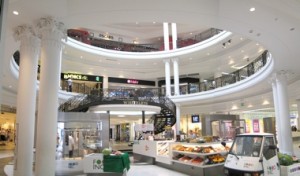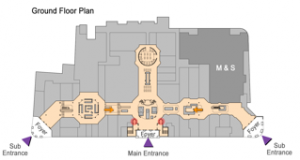This section is based on a recent research study conducted by Jae Hong Lee (2009) at University College London under the supervision of Ruth Conroy Dalton. In this study, Lee analyzed the building layouts, observed user-behavior and conducted wayfinding and other spatial cognitive experiments in a sample of four, large-scale shopping malls situated in the Greater London area: Bluewater Shopping Centre, Brent Cross Shopping Centre, Westfield Shopping Centre and Whiteleys Shopping Centre. We profile the Whiteleys Shopping Centre here. For a more detailed description please refer to Lee, J., (2009), Spatial Properties and Meanings of Atria in Built Environment, unpublished masters thesis, University College London which is available from http://eprints.ucl.ac.uk/ UCL’s institutional, research repository.
Images of the building
Whiteleys Shopping Centre, interior photograph of atrium space
Representations of building structure
Whiteleys Shopping Centre , axial line analysis indicating integration values (most integrated lines of sight = red, most segregated lines of sigh = blue).
User comments:
As part of the 2009 study, Lee conducted five interviews with shoppers in each of the malls, with the exception of Bluewater (for which permissions was not granted). Interviewees were asked to give directions to another store within each shopping center, Below are pertinent comments extracted from these transcripts:
- “Go straight… there are lifts or escalators [in the atrium], so if you take the escalator you go up, and then you have to turn right…and somewhere there…”
- “Go straight this way, and you can see ‘Marks & Spencer’, then make a left turn at the ‘Marks & Spencer’, and go straight, and then you will see on your right side.”
- “Go straight this way, and go into the buildings, and then there is a quite large open area [the atrium], walk cross there, and then it is on the first floor, so you have to go escalator, it is next to ‘Boots’ that you can see. In fact, you should be able to see it when you go in.”
- “Use escalator [the atrium], it can take you up to the second floor, and the cinema is there, you can see it.”
What is interesting about this subset of answers, is the focus on straight and direct routes (arguably the cognitively simple ones), the use of other stores as wayfinding landmarks, and the frequency with with the atria feature in these route descriptions. The focus of this study was the role in which atria play in shopping centres. The conclusion being that, as well as being a primary point of vertical circulation, atria can serve a dual function as a sort of short-cut to survey knowledge, permitting views to and knowledge of floors other than the one which the shopper is currently situated. This type of ‘knowledge-enhancement’, becomes particularly advantageous when wayfinding in an unfamiliar environment. An awareness of this provides particular spatial affordances, specific to wayfinding in complex environments.




